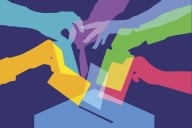You have /5 articles left.
Sign up for a free account or log in.
When Rowland Hussey Macy opened his namesake store in 1858, understanding consumer behavior was largely a matter of guessing. Retailers had little data to assess what customers wanted or how variables like store hours, assortment or pricing might impact sales. Decision making was slow: managers relied on manual sales tallies, compiled weekly or annually. Dozens of stores failed, including several of Macy’s original stores.
Predictive analytics, in the early days of retail, were rudimentary. Forward-thinking retailers combined transactional data with other types of information -- the weather, for example -- to understand the drivers of consumer behavior. In the 1970s, everything changed. Digital cash registers took hold, allowing companies to capture data and spot trends more quickly. They began A/B testing, piloting ideas in a test vs. control model, at the store level to understand the impact of strategy in near real time.
In the early days of AOL, where I worked in the 1990s and early 2000s, we were quick to recognize the risk to brick-and-mortar stores, as online retailers gathered unprecedented data on consumer behavior. Companies like Amazon could track a customer’s movements on their site using click-stream data to understand which products a customer was considering, or how long they spent comparing products before purchasing. Their brick-and-mortar counterparts, meanwhile, were stuck in the 1800s.
Unexpected innovations, however, have a funny way of leveling the playing field. Today, broadband ubiquity and the proliferation of mobile devices are enabling brick-and-mortar stores to track cell phone signals or use video surveillance to understand the way consumers navigate a store, or how much time they spend in a particular aisle. Sophisticated multichannel retailers now merge online behavior with in-person information to piece together a more holistic picture of their consumers, generating powerful data that drive changes in layout, staffing, assortment and pricing. A recent study found that 36 percent of in-store retail purchases -- worth a whopping $1.1 trillion -- are now influenced by the use of digital devices. Retailers who leverage online research to drive brick-and-mortar sales are gaining a competitive advantage.
The use of big data and predictive analytics in higher education is nascent. So-called disrupters often claim that the lecture hasn’t changed in 150 years, and that only online learning can drive transformative, game-changing outcomes for students. Of course, these claims ring hollow among today’s tech-savvy professors.
Since my transition into higher education, I have been struck by the parallel journey retailers and educators face. Both have been proclaimed obsolete at various points, but the reality is that the lecture, like the retail experience, has and will continue to evolve to meet the new demands of 21st-century users.
Like brick-and-mortar stores, lectures were once a black box -- but smart faculty members are beginning to harness the presence of mobile devices to capture unprecedented levels of data in traditional classrooms. And smart institutions are combining real-time engagement data with historic information to spot challenges early and change the academic trajectory for students.
Historical sources of student data (FAFSA, GPA, SAT, etc.) have predictive validity, but they are a bit like the year-over-year data retailers used: limited in depth and timeliness. The heart of a higher education institution is its professors -- and its classes. In addition to professors being experts in their fields, providing unique learning opportunities to their students, studies have shown that when professors have positive relationships with students, it leads to greater student success.
Some of the most interesting early data are coming from the big, first-year lecture courses. While most students experience these as a rite of passage, they also hold great potential as models of how behavioral data can improve engagement and completion rates for students. Faculty are no longer powerless in the face of larger classes and limited insight into their students' learning behavior. They can track how well students are engaging in traditional lecture classes and intervene with students who aren’t engaged in the behaviors (note taking, asking questions and attendance) that correlate with success.
Historically, professors have relied on piecemeal solutions to gather insights on student behavior. So-called student-response systems and learning management software, like digital cash registers in the ’70s, provide useful data -- but they don’t provide the sort of real-time analytics that can inform an instructor’s practice or to identify students in need of additional support and coaching.
A more recent brand of solutions -- in full disclosure, including ours at Echo360 -- are designed to work in conjunction with great teaching, while providing instructors with the tools to track and measure student engagement: Are students taking notes? Are they asking questions? These tools give administrators and instructors insight into how students are interacting and participating both in class, as well as with content or readings before and after class. No more waiting for summative tests to demonstrate that a student misunderstood a concept weeks or months earlier.
The analogy between retail and education has its limitations. The mission and objectives in education are more nuanced, and frankly, more important. However, education, like every sector, has what we call a moment of truth.
For retailers, that moment of truth is centered around the purchase decision. Sophisticated marketers and retailers have used behavioral data to become incredibly skilled at understanding and shaping that purchase decision to achieve extraordinary results.
It’s time to use those learnings for a higher calling. The explosion of digital devices in the classroom allows us to understand the learning process wherever it is happening on campus, and to support education’s vital moment of truth -- a transaction of knowledge between professors and students.







